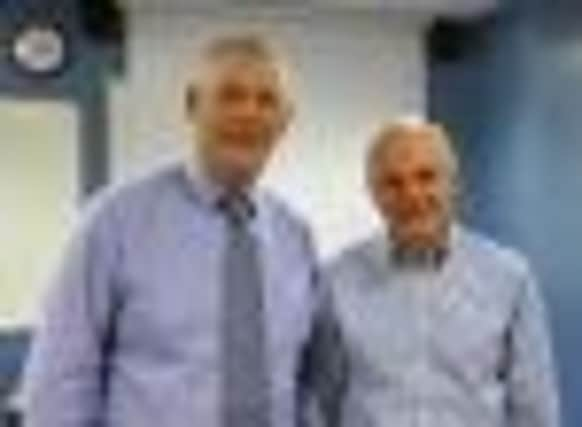Cookstown Wildlife Trust open winter programme with Falklands talk


Few are better qualified to speak on the Islands than Dr Jim McAdam who has, in total, made some 40 trips to the Falklands and last year he also visited some of the remote outer islands.
Jim was accompanied by Mrs McAdam, who has on occasions accompanied her husband to the Falklands
Advertisement
Hide AdAdvertisement
Hide AdJim first went there in 1975, as an agronomist, and stayed for three years.
1982 saw the Falklands War, but he returned again in 1983.
The islands, in total, have roughly the same area as Northern Ireland and lie at approximately the same latitude south of the equator, as we are north of it. The islands are roughly 250 miles from South America.
They are colder and more windy than Ireland due to the influence of the large Antarctic polar continent.
They lie in a zone known as the Antarctic convergence where cold and warm waters meet. The denser cold water sinks and warmer water is at the surface, leading to very productive seas.
Advertisement
Hide AdAdvertisement
Hide AdThe islands have a total population of around 2300 (roughly similar to Moneymore) with 1800 of these living in the main town, Stanley.
There are no regular ferries and most movement of people is by air transport. The outer more remote islands are the ones with most wildlife. There are no trees, but lots of gorse which came with the settlers. Much of the population is British and Irish and they still think of the British Isles as home. Some of the children go to boarding school in Dorset. The standard of living is quite high and very 21st century.
The beaches are dazzling white due to a quartz sand, with little shell material.
Overland travel is often by Land Rover. Before the war with Argentina it would have taken two days to travel 40 miles by Land Rover over the rough terrain but now only two hours with new roads.
Advertisement
Hide AdAdvertisement
Hide AdThe Airport is at Port Howard and most flights are by “Islander” aircraft which an land on the beach or in fields!
Cape Horn in the seventeenth century gave The Falklands strategic importance.
French Spanish and English have all been there the one time or another.
The sheep produce very high quality wool and the number of cattle farms have increased in recent years. Farms now owned by the islanders were previously owned by companies.
Advertisement
Hide AdAdvertisement
Hide AdCharles Darwin visited the Falklands in 1833 and 1834 and surprisingly he spent three times as long in the Falklands as he did in the Galapagos Islands. Trees are sparse on the Falklands, but there are many acid grassland plants.
A lot of these are endemic to the Islands and of bio-geographic importance,they including a tiny gunnera and a calceolaria.The 348 species of Plants are all small due to almost continuous wind.
Jim described a bog plant which lives for 200 years. Behind the shoreline (50yds. from the sea) a tussock grass 2m tall grows, this is now under threat due to cattle.
It is important as a shelter, seals breed and birds nest among the plants.
Advertisement
Hide AdAdvertisement
Hide AdIt provides good winter feed-but if eaten in summer often dies. Jim has been involved through Queen’s University Belfast in successfully regenerating the tussock grass.
Beautiful slides gave us an insight into the bird life, including the globally important Black Browed Albatross, the striking red and black Military Starling, the Patagonian snipe and Cobbs Wren which is endemic to these islands. Turkey vultures, Red Backed Hawks, Upland Geese, Steamer Ducks, Blue Eyed Shags and Black Necked Swans were all described.
We were told that the Black Browed Albatross stays on the wings for almost nine months of the year, pairs for life and lives for around 50 years. There are almost half a million pairs breeding on the Falkland Islands.
No survey of the bird life would be complete without mentioning the penguins these included Jackass Penguins, Rock Hopper Penguins.Macaroni Penguins and King Penguins.
Advertisement
Hide AdAdvertisement
Hide AdMarine mammals are abundant along the shores of the Falkland Islands. It is a stronghold for Elephant Seals which can weigh up to five tons. Southern Sea Lions need to be treated with respect as they are fast moving and vicious. Porpoises, dolphins and South American Fur Seals are frequent in the shallow around the islands.
Jim described how the cold fertile water is full of small shrimp like creatures called Krill , often washed up on the beaches. They are the staple diet of whales.
The talk ended by describing the increasing importance of tourism in the Falklands. Around 50% of the farms earn considerable money through tourist related activities. Cruise ships bring large numbers of tourists (almost 60,000 last year) on special interest tours.
Jim McAdam provided one of our best talks in recent years. Well illustrated with excellent slides, and of just the right length, he provided an overview of the Falkland Islands better than most television documentaries.
Advertisement
Hide AdAdvertisement
Hide AdCookstown Wildlife Trust meet again on Tuesday, 13 November at 7:45pm in South West College, Burn Road, Cookstown. The speaker will be George Acheson, a walker with a keen eye for wildlife and scenery. Last year George gave us an interesting and well illustrated talk on “Birds of the Mournes”. This year his topic is “ Coast to Coast ” about his recent walk across the Pennines.
Visit our web site www.Cookstownwildlifetrust.info to find details on the Trust and some interesting information on local wildlife.